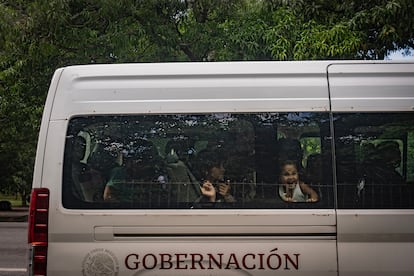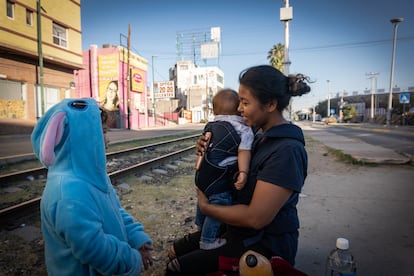Minor migrants in transit through Mexico increase by 514% in six years
Figures on registration of children and teens on their way to the United States reflect that more families now undertake the journey together, and show a marked increase in Venezuelan nationals


The sight of migrant children in Mexico is becoming more and more common. As the last transit country on the way to a border that is seen in their imagination as the gateway to a prosperous future, Mexican figures serve to shed light on the shadows of migration statistics. The latest update of 2024 data from government agencies evidences a continued increase in the number of migrant minors registered by the Mexican authorities in recent years. Between January and August 2024, 108,444 minors under 18 years of age were processed in Mexico, an increase of 514% compared to the same period in 2018.
The figures are remarkable even compared with the entirety of 2023, when Mexican authorities registered 113,542 undocumented minors. They are a testament to a gradual year-over-year increase — with the exception of 2020, when, due to the Covid pandemic, the numbers dropped dramatically before resuming an upward pace. The data are consistent with the enormous overall increase in migrant arrivals in the United States after the Covid pause and throughout the administration of Joe Biden, until the Democratic president tightened the border in the middle of last year.
In addition to the skyrocketing numbers of migrant children in transit through Mexico, another notable change is in terms of unaccompanied minors. In 2018, when Donald Trump was in the middle of his first presidency, the majority of minors registered by Mexican authorities were traveling alone and were mainly teenagers, although some were even younger. That trend has been completely reversed: Between January and August 2024, only 4,283 of the more than 100,000 registered minors were traveling alone. This also conceals another fact: last year, children under 11 years old accounted for 72% of all the registered minors, while six years ago they were 43% of the total.
The picture these figures paint is consistent with the reality reported from the field: the old figure of the single adult man who has left his family behind has been replaced with entire families migrating together.

Migration can be a trauma for minors, who are especially vulnerable to many forms of violence along their journey. In light of this, the Mexico City Human Rights Commission (CDHCM) has stressed “the need to address the migration phenomenon with a comprehensive and differentiated approach for priority groups, which contributes to improving access to health, education, and recreational services, among others, as well as reducing social conflict.”
The departure point of migrant minors has changed in the same way as the general trends. Statistics show that six years ago the Northern Triangle of Central America—Guatemala, Honduras, and El Salvador—contributed the vast majority of migrants in transit through Mexico on their way north; these days, Venezuela is the country of origin of most children and adolescents registered by Mexican authorities, and who typically travel with their parents and siblings. The figures speak for themselves: in the first eight months of last year, 46,384 Venezuelan minors were detected crossing Mexico. In 2018, there were only 37.
The reasons why so many Venezuelans have left their country in recent years — the deep economic and democratic crisis — are well documented. It is less clear why entire families are now traveling from all over the region, rather than single adults first who later send for their children, as used to be the case.
According to migrant rights groups, there are two main reasons. On the one hand, they say, the crisis is so deep that parents do not want to leave their children behind, as they see no chance for them even in the short term. They feel it is better to try their luck in the jungle and on the dangerous roads to the north than to leave them to their fate with grandparents or other relatives.

On the other hand, several reports cite the false belief that if you travel with children there is a better chance that you will be allowed to stay in the United States permanently. There is no evidence of this in the facts, and with Trump’s return to the White House just around the corner, and the hostile environment towards migrants that reached its peak during his first term with the family separation policy, the outlook is not very positive. With Trump’s plan for mass deportations and other plans that explicitly seek to discourage migration, it remains to be seen whether the numbers of migrants crossing Mexico on their way to the U.S. will also decrease.
Sign up for our weekly newsletter to get more English-language news coverage from EL PAÍS USA Edition
Tu suscripción se está usando en otro dispositivo
¿Quieres añadir otro usuario a tu suscripción?
Si continúas leyendo en este dispositivo, no se podrá leer en el otro.
FlechaTu suscripción se está usando en otro dispositivo y solo puedes acceder a EL PAÍS desde un dispositivo a la vez.
Si quieres compartir tu cuenta, cambia tu suscripción a la modalidad Premium, así podrás añadir otro usuario. Cada uno accederá con su propia cuenta de email, lo que os permitirá personalizar vuestra experiencia en EL PAÍS.
¿Tienes una suscripción de empresa? Accede aquí para contratar más cuentas.
En el caso de no saber quién está usando tu cuenta, te recomendamos cambiar tu contraseña aquí.
Si decides continuar compartiendo tu cuenta, este mensaje se mostrará en tu dispositivo y en el de la otra persona que está usando tu cuenta de forma indefinida, afectando a tu experiencia de lectura. Puedes consultar aquí los términos y condiciones de la suscripción digital.
More information
Archived In
Últimas noticias
Raúl Rocha, from jet-setting with Miss Universe to arms trafficking and fuel theft
80,000 barrels of Mexican oil sent to Cuba: Havana drawn into the US–Mexico clash
Human rights activists, opposition members, and a minor: Maduro’s other political prisoners
Israel sparks a civil war within the MAGA movement
Most viewed
- Reinhard Genzel, Nobel laureate in physics: ‘One-minute videos will never give you the truth’
- Pablo Escobar’s hippos: A serious environmental problem, 40 years on
- Charles Dubouloz, mountaineering star, retires at 36 with a farewell tour inspired by Walter Bonatti
- Why we lost the habit of sleeping in two segments and how that changed our sense of time
- The fall of a prolific science journal exposes the billion-dollar profits of scientific publishing










































